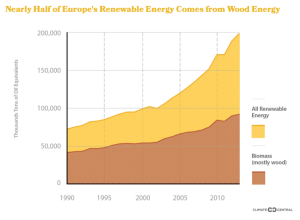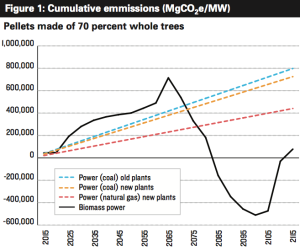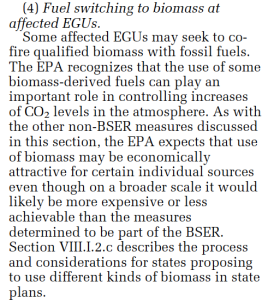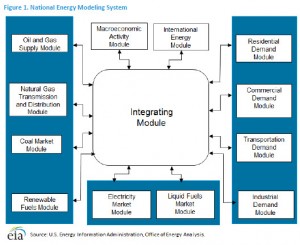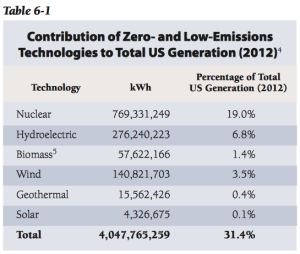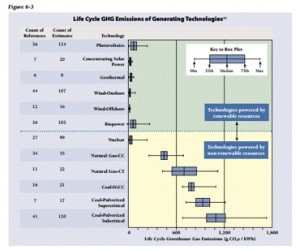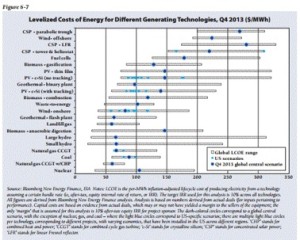Peter Lobner
EU policy background
The United Nations Framework Convention on Climate Change (The Paris Agreement) entered into force on 4 November 2016. To date, the Paris Agreement has been ratified by 122 of the 197 parties to the convention. This Agreement does not define renewable energy sources, and does not even use the words “renewable,” “biomass,” or “wood”. You can download this Agreement at the following link:
http://unfccc.int/paris_agreement/items/9485.php
The Renewable Energy Policy Network for the 21st Century (REN21), based in Paris, France, is described as, “a global renewable energy multi-stakeholder policy network that provides international leadership for the rapid transition to renewable energy.” Their recent report, “Renewables 2016 Global Status Report,” provides an up-to-date summary of the status of the renewable energy industry, including the biomass industry, which accounts for the use of wood as a renewable biomass fuel. The REN21 report notes:
“Ongoing debate about the sustainability of bioenergy, including indirect land-use change and carbon balance, also affected development of this sector. Given these challenges, national policy frameworks continue to have a large influence on deployment.”
You can download the 2016 REN21 report at the following link:
http://www.ren21.net/wp-content/uploads/2016/05/GSR_2016_Full_Report_lowres.pdf
For a revealing look at the European Union’s (EU) position on the use of biomass as an energy source, see the September 2015 European Parliament briefing, “Biomass for electricity and heating opportunities and challenges,” at the following link:
http://www.europarl.europa.eu/RegData/etudes/BRIE/2015/568329/EPRS_BRI(2015)568329_EN.pdf
Here you’ll see that burning biomass as an energy source in the EU is accorded similar carbon-neutral status to generating energy from wind, solar and hydro. The EU’s rationale is stated as follows:
“Under EU legislation, biomass is carbon neutral, based on the assumption that the carbon released when solid biomass is burned will be re-absorbed during tree growth. Current EU policies provide incentives to use biomass for power generation.”
This policy framework, which treats biomass as a carbon neutral energy source, is set by the EU’s 2009 Renewable Energy Directive (Directive 2009/28/EC), which requires that renewable energy sources account for 20% of the EU energy mix by 2020. You can download this directive at the following link:
http://eur-lex.europa.eu/legal-content/EN/TXT/?qid=1436259271952&uri=CELEX:02009L0028-20130701
The EU’s equation seems pretty simple: renewable = carbon neutral
EU policy assessment
In 2015, the organization Climate Central produced an assessment of this EU policy in a three-part document entitled, “Pulp Fiction – The European Accounting Error That’s Warming the Planet.” Their key points are summarized in the following quotes extracted from “Pulp Fiction”:
“Wood has quietly become the largest source of what counts as ‘renewable’ energy in the EU. Wood burning in Europe produced as much energy as burning 620 million barrels of oil last year (both in power plants and for home heating). That accounted for nearly half of all Europe’s renewable energy. That’s helping nations meet the requirements of EU climate laws on paper, if not in spirit.”
“The wood pellet mills are paying for trees to be cut down — trees that could be used by other industries, or left to grow and absorb carbon dioxide. And the mills are being bankrolled by climate subsidies in Europe, where wood pellets are replacing coal at a growing number of power plants.”
”That loophole treats electricity generated by burning wood as a ‘carbon neutral’ or ‘zero emissions’ energy source — the same as solar panels or wind turbines. When power plants in major European countries burn wood, the only carbon dioxide pollution they report is from the burning of fossil fuels needed to manufacture and transport the woody fuel. European law assumes climate pollution released directly by burning fuel made from trees doesn’t matter, because it will be re-absorbed by trees that grow to replace them.”
“Burning wood pellets to produce a megawatt-hour of electricity produces 15 to 20 percent more climate-changing carbon dioxide pollution than burning coal, analysis of Drax (a UK power plant) data shows. And that’s just the CO2 pouring out of the smokestack. Add in pollution from the fuel needed to grind, heat and dry the wood, plus transportation of the pellets, and the climate impacts are even worse. According to Enviva (a fuel pellet manufacturer), that adds another 20 percent worth of climate pollution for that one megawatt-hour.”
“No other country or U.S. region produces more wood and pulp every year than the Southeast, where loggers are cutting down roughly twice as many trees as they were in the 1950s.”
“But as this five-month Climate Central investigation reveals, renewable energy doesn’t necessarily mean clean energy. Burning trees as fuel in power plants is heating the atmosphere more quickly than coal.”
You can access the first part of “Pulp Fiction” at the following link and then easily navigate to the other two parts.
http://reports.climatecentral.org/pulp-fiction/1/
In the U.S., the Natural Resources Defense Council (NRDC) has made a similar finding. Check out the NRDC’s May 2015 Issue Brief, “Think Wood Pellets are Green? Think Again,” at the following link:
https://www.nrdc.org/sites/default/files/bioenergy-modelling-IB.pdf
NRDC examined three cases of cumulative emissions from fuel pellets made from 70%, 40% and 20% whole trees. The NRDC chart for the 70% whole tree case is shown below.
You can see that the NRDC analysis indicates that cumulative emissions from burning wood pellets exceeds the cumulative emissions from coal and natural gas for many decades. After about 50 years, forest regrowth can recapture enough carbon to offset the cumulative emissions from wood pellets to below the levels for of fossil fuels. It takes about 15 – 20 more years to reach “carbon neutral” (zero net CO2 emissions) in the early 2080s.
The NRDC report concludes
“In sum, our modeling shows that wood pellets made of whole trees from bottomland hardwoods in the Atlantic plain of the U.S. Southeast—even in relatively small proportions— will emit carbon pollution comparable to or in excess of fossil fuels for approximately five decades. This 5-decade time period is significant: climate policy imperatives require dramatic short-term reductions in greenhouse gas emissions, and emissions from these pellets will persist in the atmosphere well past the time when significant reductions are needed.“
The situation in the U.S.
The U.S. Clean Power Plan, Section V.A, “The Best System of Emission Reduction,” (BSER) defines EPA’s determination of the BESR for reducing CO2 emissions from existing electric generating units. In Section V.A.6, EPA identifies areas of compliance flexibility not included in the BESR. Here’s what EPA offers regarding the use of biomass as a substitute for fossil fuels.
This sounds a lot like what is happening at the Drax power plant in the UK, where three of the six Drax units are co-firing wood pellets along with the other three units that still are operating with coal.
Fortunately, this co-firing option is a less attractive option under the Clean Power Plan than it is under the EU’s Renewable Energy Directive.
You can download the EPA’s Clean Power Plan at the following link:
https://www.epa.gov/cleanpowerplan/clean-power-plan-existing-power-plants#CPP-final
On 9 February 2016, the U.S. Supreme Court stayed implementation of the Clean Power Plan pending judicial review.
In conclusion
The character J. Wellington Wimpy in the Popeye cartoon by Hy Eisman is well known for his penchant for asking for a hamburger today in exchange for a commitment to pay for it in the future.
It seems to me that the EU’s Renewable Energy Directive is based on a similar philosophy. The “renewable” biomass carbon debt being accumulated now by the EU will not be repaid for 50 – 80 years.
The EU’s Renewable Energy Directive is little more than a time-shifted carbon trading scheme in which the cumulative CO2 emissions from burning a particular carbon-based fuel (wood pellets) are mitigated by future carbon sequestration in new-growth forests. This assumes that the new-growth forests are re-planted as aggressively as the old-growth forests are harvested for their biomass fuel content. By accepting this time-shifted carbon trading scheme, the EU has accepted a 50 – 80 year delay in tangible reductions in the cumulative emissions from burning carbon-based fuels (fossil or biomass).
So, if the EU’s Renewable Energy Directive is acceptable for biomass, why couldn’t a similar directive be developed for fossil fuels, which, pound-for-pound, have lower emissions than biomass? The same type of time-shifted carbon trading scheme could be achieved by aggressively planting new-growth forests all around the world to deliver the level of carbon sequestration needed to enable any fossil fuel to meet the same “carbon neutral” criteria that the EU Parliament, in all their wisdom, has applied to biomass.
If the EU Parliament truly accepts what they have done in their Renewable Energy Directive, then I challenge them to extend that “Wimpy” Directive to treat all carbon-based fuels on a common time-shifted carbon trading basis.
I think a better approach would be for the EU to eliminate the “carbon neutral” status of biomass and treat it the same as fossil fuels. Then the economic incentives for burning the more-polluting wood pellets would be eliminated, large-scale deforestation would be avoided, and utilities would refocus their portfolios of renewable energy sources on generators that really are “carbon neutral”.
